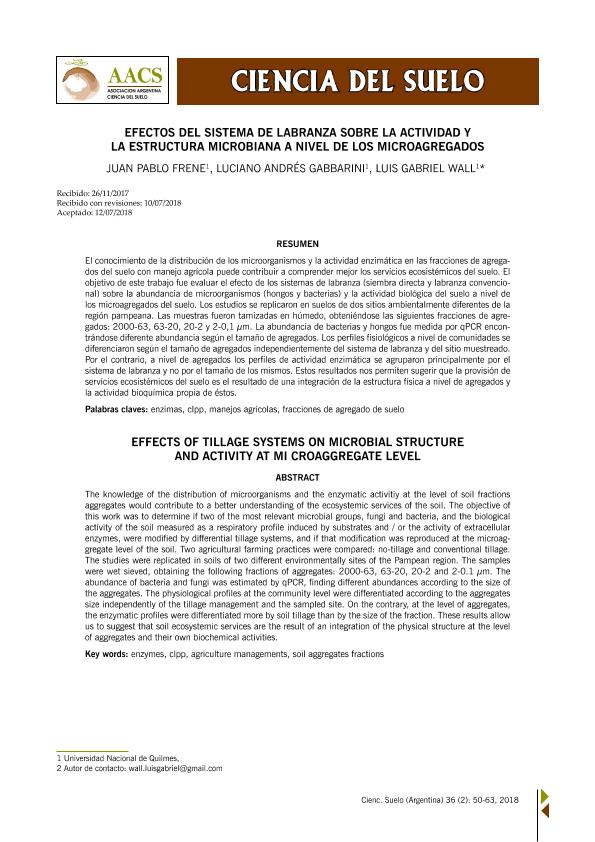Artículo
El conocimiento de la distribución de los microorganismos y la actividad enzimática en las fracciones de agregadosdel suelo con manejo agrícola puede contribuir a comprender mejor los servicios ecosistémicos del suelo. Elobjetivo de este trabajo fue evaluar el efecto de los sistemas de labranza (siembra directa y labranza convencional)sobre la abundancia de microorganismos (hongos y bacterias) y la actividad biológica del suelo a nivel delos microagregados del suelo. Los estudios se replicaron en suelos de dos sitios ambientalmente diferentes de laregión pampeana. Las muestras fueron tamizadas en húmedo, obteniéndose las siguientes fracciones de agregados:2000-63, 63-20, 20-2 y 2-0,1 μm. La abundancia de bacterias y hongos fue medida por qPCR encontrándosediferente abundancia según el tamaño de agregados. Los perfiles fisiológicos a nivel de comunidades sediferenciaron según el tamaño de agregados independientemente del sistema de labranza y del sitio muestreado.Por el contrario, a nivel de agregados los perfiles de actividad enzimática se agruparon principalmente por elsistema de labranza y no por el tamaño de los mismos. Estos resultados nos permiten sugerir que la provisión deservicios ecosistémicos del suelo es el resultado de una integración de la estructura física a nivel de agregados yla actividad bioquímica propia de éstos. The knowledge of the distribution of microorganisms and the enzymatic activitiy at the level of soil fractions aggregates would contribute to a better understanding of the ecosystemic services of the soil. The objective of this work was to determine if two of the most relevant microbial groups, fungi and bacteria, and the biological activity of the soil measured as a respiratory profile induced by substrates and / or the activity of extracellular enzymes, were modified by differential tillage systems, and if that modification was reproduced at the microaggregate level of the soil. Two agricultural farming practices were compared: no-tillage and conventional tillage. The studies were replicated in soils of two different environmentally sites of the Pampean region. The samples were wet sieved, obtaining the following fractions of aggregates: 2000-63, 63-20, 20-2 and 2-0.1 µm. The abundance of bacteria and fungi was estimated by qPCR, finding different abundances according to the size of the aggregates. The physiological profiles at the community level were differentiated according to the aggregates size independently of the tillage management and the sampled site. On the contrary, at the level of aggregates, the enzymatic profiles were differentiated more by soil tillage than by the size of the fraction. These results allow us to suggest that soil ecosystemic services are the result of an integration of the physical structure at the level of aggregates and their own biochemical activities.
Efectos del sistema de labranza sobre la actividad y la estructura microbiana a nivel de los microagregados
Título:
Effects of tillage systems on microbial structure and activity at microaggregate level
Fecha de publicación:
07/2018
Editorial:
Asociación Argentina de la Ciencia del Suelo
Revista:
Ciencia del Suelo
ISSN:
0326-3169
Idioma:
Español
Tipo de recurso:
Artículo publicado
Clasificación temática:
Resumen
Palabras clave:
ENZIMAS
,
CLPP
,
MANEJOS AGRICOLAS
,
AGREGADOS DE SUELO
Archivos asociados
Licencia
Identificadores
Colecciones
Articulos(SEDE CENTRAL)
Articulos de SEDE CENTRAL
Articulos de SEDE CENTRAL
Citación
Frene, Juan Pablo; Gabbarini, Luciano Andres; Wall, Luis Gabriel; Efectos del sistema de labranza sobre la actividad y la estructura microbiana a nivel de los microagregados; Asociación Argentina de la Ciencia del Suelo; Ciencia del Suelo; 36; 7-2018; 50-63
Compartir




